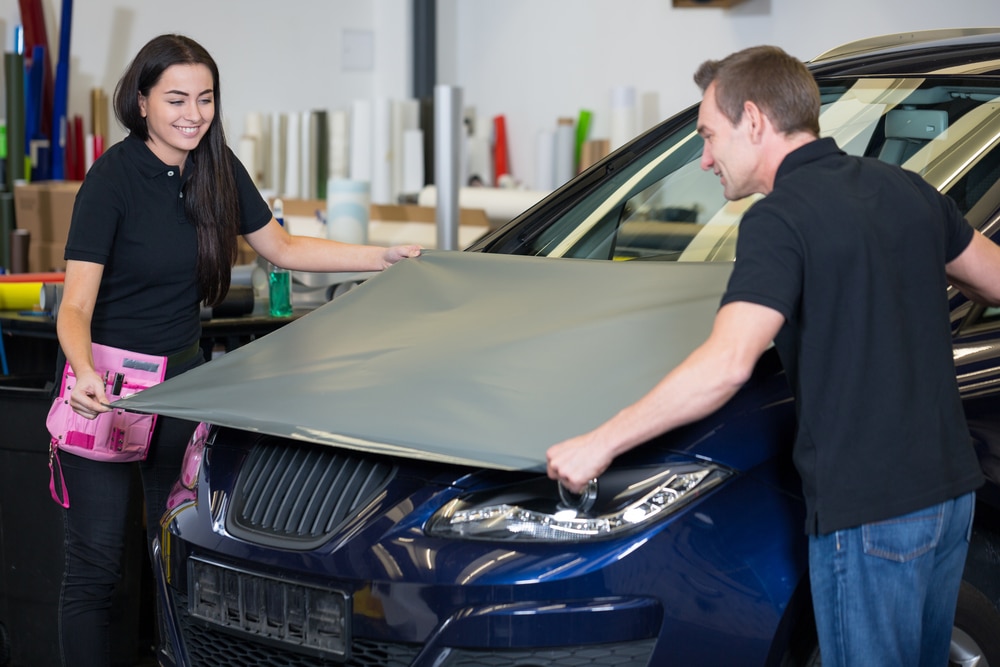It’s a wonder that more people don’t make use of vehicle wraps. It is a relatively easy way to change the color of your vehicle, whether fully or partially. It’s also a great way to add all sorts of graphics without having to hand-paint them in place (or pay for someone else to do so). Apart from the obvious aesthetic benefits, vehicle wraps also have a lot of versatility. As such, many different options exist. Let’s go over some of the more common types of vehicle wraps on the market today.
Full Wraps
The name is very self-explanatory. A full wrap covers the entire vehicle, changing its color and appearance completely. In most cases, this is done using a solid color. Not only is it cheaper than a full paint job, but it is also completely reversible. This is called a “color change wrap.” Some people will even use a full wrap that is the same color as the car underneath. Why, you ask? To protect the real finish of the car from minor bumps and scratches, of course. That’s what is known as a “protective wrap.”
Full wraps are obviously a little more expensive than partial wraps, but they are the easiest way to change the entire exterior of a vehicle. In some cases, people don’t actually want to permanently change the color or look of their vehicle. The ability to simply change your mind and go back to the old color is very appealing to some.
Commercial Wraps
When done in a commercial setting, a full or partial wrap is more likely to be a printed wrap. That is to say, it will be done using a piece of material that has been printed with all sorts of graphics related to that business. Many companies have these types of “mascot vehicles” and they can be very helpful for marketing purposes. Just driving such a vehicle around town constitutes some very cheap advertising. Commercial wraps can be done as full or partial wraps, depending on the desires of those involved.
Partial Wraps
As you might guess from the name, partial wraps only cover a certain part of the vehicle. This may not grab as much attention as a full wrap, but not everyone wants to do that. If you are going for a more subtle effect, or if you simply don’t want to change the look of your vehicle that much, a partial wrap can be a great way to go.
When you are using your wrapped vehicle for promotional purposes. a partial wrap might be just as effective. Particularly, it will be fine to use a partial wrap if the vehicle itself is remarkable in some way. Anything that attracts attention will serve the same purpose in the end. Partial wraps are commonly used to cover the hood, roof, trunk, and/or doors. All of these make for nice flat(ish) surfaces on which to emblazon something extra.
Carbon Fiber Wraps
Most vehicle wraps are made from vinyl, but there are some exceptions. For instance, there are some wraps that are made from carbon fibers. This gives the vehicle a matte greyish-black color and an interesting texture. Not only that, but it is very strong and resistant to damage. Thus, a carbon fiber wrap is ideal for a protective wrap, especially if you happen to like its appearance.
By all accounts, carbon fiber wraps are more difficult to apply, especially if you are going for a full wrap. Most people say that you should get professional help before doing one of those. One little downside is the fact that it won’t look like the real thing on close inspection.
Chrome Wraps
Have you ever wanted a car that was plated with solid chrome? Chances are, you can’t afford such. However, a chrome vehicle wrap would be the next best thing. The most obvious benefit of this wrap is the flashy and stunning appearance of the chrome itself. This kind of wrap is heavier, though, and will be much more difficult to apply. It is generally not recommended that you try to do this one without professional help.
Chrome wraps have another added benefit: Because they reflect sunlight, they also keep your car from absorbing so much heat. Thus, your car won’t get so burning hot in the summertime. That factor alone almost makes a chrome wrap worth its cost.
Calendared Versus Cast Vinyl
As we said earlier, the vast majority of vehicle wraps are made from vinyl. Even those that are made from other materials are usually composites. Thus, you should probably know that there are two types of vinyl: Calendared and cast.
Cast vinyl is exactly what you would expect. It has been cast in a mold and printed with the design or color desired by the maker. This type of plastic tends to be a little bit stronger and more durable, and vehicle wraps made from cast vinyl can attain the same strength with less material. Thus, they tend to be thinner than those made from calendared vinyl. This quality makes them much more flexible, and that can really help them to cover small and contoured spaces.
Calendared vinyl is produced using heat and pressure, and the process is much cheaper than casting. However, because it is not quite as strong, it tends to be thicker. In spite of this problem, however, calendared vinyl is generally the more popular choice. It’s just a lot more budget-friendly than the cast options.
Conclusion
You may have thought that all vehicle wraps were the same, but it’s not a simple science. However, this article has covered all the basic types, so you should now have a good idea of how things work. If you now find yourself wondering: “what are the best car wrap companies near me?” then we have the answer. For vehicle wraps Delaware has the best company around, which is Tupp Signs. For more information, call 302-322-1600.


